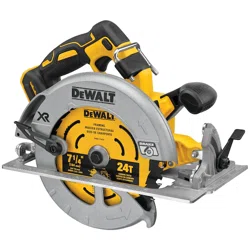Loading ...
Loading ...
Loading ...

English
13
3. Loosen bevel adjustment lever (
10
, Fig.L). Place
a square against the blade and shoe to adjust the
90°setting.
4. Turn the calibration screw
18
so that the shoe will stop
at the properangle.
5. Confirm the accuracy of the setting by checking the
squareness of an actual cut on a scrap piece ofmaterial.
Fig. M
18
Kerf Indicator (Fig.N)
The front of the saw shoe has a kerf indicator
9
for vertical
and bevel cutting. This indicator enables you to guide the
saw along cutting lines penciled on the material being cut.
The kerf indicator lines up with the left (inner) side of the
saw blade, which makes the slot or “kerf” cut by the moving
blade fall to the right of the indicator. Guide along the
penciled cutting line so that the kerf falls into the waste or
surplusmaterial.
Fig. N
9
Workpiece Support (Fig.O–Q)
WARNING: It is important to support the work
properly and to hold the saw firmly to prevent loss of
control which could cause personal injury. FigureO
illustrates proper hand support of the saw. Maintain
a firm grip with both hands on the saw and position
your body and arm to allow you to resist kickback
if it occurs. ALWAYS TURN OFF TOOL AND REMOVE
BATTERY BEFORE MAKING ANY ADJUSTMENTS!
Fig. O
Figure O shows proper sawing position. Note that hands
are kept away from cutting area. To avoid kickback, DO
support board or panel NEAR the cut (Fig.P). DON’T support
board or panel away from the cut (Fig.Q).
Place the work with its “good” side – the one on which
appearance is most important – down. The saw cuts
upward, so any splintering will be on the work face that is
up when you cutit.
Fig. P
Fig. Q
Cutting (Fig. P)
Place the wider portion of the saw shoe on that part of the
workpiece which is solidly supported, not on the section
that will fall off when the cut is made. As an example,
FigureP illustrates the RIGHT way to cut off the end of a
board. Always clamp work. Don’t try to hold short pieces by
hand! Remember to support cantilevered and overhanging
material. Use caution when sawing material frombelow.
Be sure saw is up to full speed before blade contacts
material to be cut. Starting saw with blade against material
to be cut or pushed forward into kerf can result in kickback.
Push the saw forward at a speed which allows the blade to
cut withoutlaboring.
Hardness and toughness can vary even in the same piece of
material, and knotty or damp sections can put a heavy load
on the saw. When this happens, push the saw more slowly,
but hard enough to keep working without much decrease
in speed. Forcing the saw can cause rough cuts, inaccuracy,
kickback, and over-heating of themotor.
Should your cut begin to go off the line, don’t try to force
it back on. Release the trigger switch and allow blade to
come to a complete stop. Then you can withdraw the saw,
sight anew, and start a new cut slightly inside the wrong
one. Withdraw the saw if you must shift the cut. Forcing
a correction inside the cut can stall the saw and lead
tokickback.
IF SAW STALLS, RELEASE THE TRIGGER SWITCH AND
BACK THE SAW UNTIL IT IS LOOSE. BE SURE BLADE IS
STRAIGHT IN THE CUT AND CLEAR OF THE CUTTING EDGE
BEFORERESTARTING.
Loading ...
Loading ...
Loading ...
